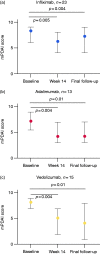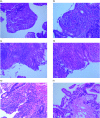Outcome of biological therapies in chronic antibiotic-refractory pouchitis: A retrospective single-centre experience
- PMID: 31700634
- PMCID: PMC6826521
- DOI: 10.1177/2050640619871797
Outcome of biological therapies in chronic antibiotic-refractory pouchitis: A retrospective single-centre experience
Abstract
Background: In limited retrospective series, infliximab, adalimumab and vedolizumab have demonstrated efficacy in chronic antibiotic-refractory pouchitis. Here, we report single-centre data of all biological therapies in refractory pouchitis.
Methods: We retrospectively assessed all records from patients with ulcerative colitis and ileal pouch -anal anastomosis who received infliximab, adalimumab or vedolizumab for pouchitis. Clinically relevant remission, defined as a modified Pouchitis Disease Activity Index <5 and a reduction of modified Pouchitis Disease Activity Index ≥2 points from baseline, was assessed at week 14.
Results: Thirty-three unique patients were identified. Prior to colectomy, patients had been exposed to cyclosporine (n = 14), infliximab (n = 12), adalimumab (n = 3), and/or vedolizumab (n = 3). All developed chronic antibiotic-refractory pouchitis, for which they received infliximab (n = 23), adalimumab (n = 13) or vedolizumab (n = 15). Clinically relevant remission was observed in 43.5% of patients in the infliximab group, and in 38.5% and 60.0% in the adalimumab and vedolizumab group, respectively. In the long-term, significantly more patients continued vedolizumab compared to anti-tumour necrosis factor (anti-TNF) therapy (hazard ratio 3.0, p = 0.04). Adverse events (mainly infusion reactions) explained 40.7% of the patients discontinuing anti-TNF therapy, whereas discontinuation of vedolizumab was only related to insufficient efficacy. Four patients eventually required a permanent ileostomy.
Conclusion: In this case series of chronic antibiotic-refractory pouchitis, biological therapy was effective in the majority of patients and only a minority eventually required a permanent ileostomy. The use of anti-TNF agents was hampered by a high rate of adverse events, partly related to immunogenicity as some patients had been exposed to anti-TNF prior to colectomy. Vedolizumab was also efficacious and may provide a safe alternative in these chronic antibiotic-refractory pouchitis patients.
Keywords: Chronic pouchitis; adalimumab; biological therapy; infliximab; ulcerative colitis; vedolizumab.
© Author(s) 2019.
Figures





Similar articles
-
Systematic Review With Meta-Analysis: Anti-TNF Therapy in Refractory Pouchitis and Crohn's Disease-Like Complications of the Pouch After Ileal Pouch-Anal Anastomosis Following Colectomy for Ulcerative Colitis.Inflamm Bowel Dis. 2018 Jan 18;24(2):261-268. doi: 10.1093/ibd/izx049. Inflamm Bowel Dis. 2018. PMID: 29361101
-
Identification of the Most Cost-effective Position of Vedolizumab Among the Available Biologic Drugs for the Treatment of Ulcerative Colitis.J Crohns Colitis. 2020 Jun 19;14(5):575-587. doi: 10.1093/ecco-jcc/jjz212. J Crohns Colitis. 2020. PMID: 31901085 Free PMC article.
-
Vedolizumab for the Treatment of Chronic Pouchitis.N Engl J Med. 2023 Mar 30;388(13):1191-1200. doi: 10.1056/NEJMoa2208450. N Engl J Med. 2023. PMID: 36988594 Clinical Trial.
-
[A case of refractory pouchitis following surgery for ulcerative colitis successfully treated with adalimumab].Nihon Shokakibyo Gakkai Zasshi. 2019;116(9):732-738. doi: 10.11405/nisshoshi.116.732. Nihon Shokakibyo Gakkai Zasshi. 2019. PMID: 31511459 Japanese.
-
Use of Biologics for the Treatment of Inflammatory Conditions of the Pouch: A Systematic Review.J Clin Gastroenterol. 2024 Feb 1;58(2):183-194. doi: 10.1097/MCG.0000000000001828. J Clin Gastroenterol. 2024. PMID: 36753457
Cited by
-
Ileal Pouch-Anal Anastomosis in the Older Adult: a Review of Postoperative Outcomes and Pouchitis Treatment.Curr Treat Options Gastroenterol. 2022 Dec;20(4):564-581. doi: 10.1007/s11938-022-00405-x. Epub 2022 Dec 6. Curr Treat Options Gastroenterol. 2022. PMID: 36844648 Free PMC article.
-
α4β7 integrin-dependent adhesion of T cells to MAdCAM-1 is blocked by vedolizumab in patients with chronic refractory pouchitis.Therap Adv Gastroenterol. 2021 Nov 24;14:17562848211054707. doi: 10.1177/17562848211054707. eCollection 2021. Therap Adv Gastroenterol. 2021. PMID: 34868349 Free PMC article.
-
Personalized Approach to Chronic Antibiotic-Refractory Pouchitis: A Case Report and Review of the Literature.Cureus. 2024 Feb 1;16(2):e53398. doi: 10.7759/cureus.53398. eCollection 2024 Feb. Cureus. 2024. PMID: 38435148 Free PMC article.
-
Tofacitinib in chronic pouchitis: A step towards addressing an unmet need.United European Gastroenterol J. 2025 May;13(4):501-502. doi: 10.1002/ueg2.12691. Epub 2024 Nov 7. United European Gastroenterol J. 2025. PMID: 39508365 Free PMC article. No abstract available.
-
Comprehensive systematic review and pooled analysis of real-world studies evaluating immunomodulator and biologic therapies for chronic pouchitis treatment.JGH Open. 2023 Dec 7;7(12):899-907. doi: 10.1002/jgh3.13000. eCollection 2023 Dec. JGH Open. 2023. PMID: 38162843 Free PMC article.
References
-
- Shen B. Acute and chronic pouchitis–pathogenesis, diagnosis and treatment. Nat Rev Gastroenterol Hepatol 2012; 9: 323–333. - PubMed
-
- Magro F, Gionchetti P, Eliakim R, et al. Third European Evidence-Based Consensus on Diagnosis and Management of Ulcerative Colitis. Part 1: Definitions, diagnosis, extra-intestinal manifestations, pregnancy, cancer surveillance, surgery, and ileo-anal pouch disorders. J Crohns Colitis 2017. Jun 1; 1(6): 649–670. doi: 10.1093/ecco-jcc/jjx008. - PubMed
-
- Zittan E, Wong-Chong N, Ma GW, et al. Modified two-stage ileal pouch-anal anastomosis results in lower rate of anastomotic leak compared with traditional two-stage surgery for ulcerative colitis. J Crohns Colitis 2016; 10: 766–772. - PubMed
-
- Germain A, de Buck van Overstraeten A, Wolthuis A, et al. Outcome of restorative proctocolectomy with an ileo-anal pouch for ulcerative colitis: Effect of changes in clinical practice. Colorectal Dis 2018; 20: O30–O38. - PubMed
-
- de Buck van Overstraeten A, Wolthuis AM, Vermeire S, et al. Long-term functional outcome after ileal pouch anal anastomosis in 191 patients with ulcerative colitis. J Crohns Colitis 2014; 8: 1261–1266. - PubMed
MeSH terms
Substances
LinkOut - more resources
Full Text Sources

